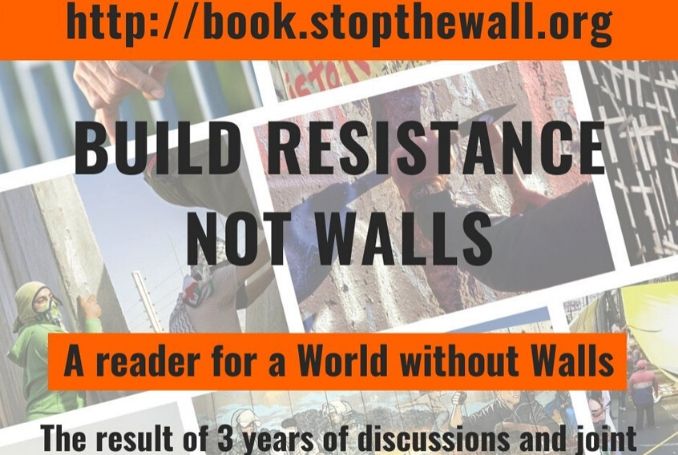
By Jim Miles
(Build Resistance not Walls: A Reader for a World without Walls. Ed. Palestinian Grassroots Anti-Apartheid Wall Campaign, Stop the Wall. November 09, 2019.)
A collection of essays concerning the boundaries being established by walls, Build Resistance not Walls centers its arguments on the walls of Palestine: the so-called security fence that runs some 700 km through Palestinian lands of the West Bank, and the Gaza wall of various constructions that is about 60 km long.
It goes far beyond these two physical manifestations of walls, taking the reader into global geographies and into global ideologies, strategies, and mindsets using walls to, essentially control global populations.
It is in essence about the extension of the global frontiers of empire, an empire based on corporate capitalism that dehumanizes the majority of people and destroys environments, while extracting profits for the elites. The empire is based on Israeli-American desires of hegemonic control.
The essays speak for themselves on different topics, but several themes are common to all sections of the work.
The most common element is how Israel plays a dominant role in the physical structures of different walls. Their militarized expertise is advertised as being “field-tested”, an acknowledgment of their use of various mechanisms and structures to control and subjugate a population. Several major Israeli companies sell directly or have subsidiaries selling hardware of different kinds – imaging devices, sound detection systems, radar, facial recognition, drones – as well as selling techniques for crowd control in general, at walls or away as desired.
It also sells techniques for individual controls (passbooks, intimidation, delays, beatings, interrogation, torture, rape), techniques also used by the former School of the Americas, now WHINSEC (Western Hemisphere Institute for Security Cooperation).
Another general common element is the recognition that walls are used to create separations between “us” and “others” with the latter being basically subhuman, beyond the law and thus can be easily killed, ignored, or mistreated in any manner. The context in which this duality exists comes from the corporate world and its capitalist requirements for exploitable labor, constrained labor, while resources and profits flow out of one country or region into the banks and homes of the privileged elites. It is “the hegemonic structure of exclusion, exploitation, discrimination, and destruction.”
Walls in this sense strip people of their culture, their land, their means of making a living. This is more and more a global phenomenon with walls of some kind being represented from the favela slums of Rio de Janeiro, through the European neocolonial walls in Morocco, the physical wall for northern Mexico and its subordinate walls attempting to keep migrants away at Mexico’s contact with the Central American republics.
As another theme, walls are not exclusively physical barriers. Many walls are constructed by different legalities, the various so-called free trade agreements being prime barriers, with Mexico being a prime example. With the creation of NAFTA, Mexican farmers were devastated with the import of cheap (subsidized )imported U.S. corn and meat products.
Having lost their lands the farmers then became subject to the regimes of exploited labor made possible by the corporate interests embedded in NAFTA. Corporate elites are the main beneficiaries, both for general manufacturing but in particular, those industries aligned with weapons, security infrastructure, and extending into personnel requirements (e.g. private for-profit prisons).
The theme of “frontiers” is brought up frequently. The developed countries, the U.S. and the European Union, in particular, maintain their frontiers largely away from their homelands. Other countries are encouraged-bribed-forced to create barriers of some kind or another to keep recalcitrant and belligerent local indigenous populations under control in order that corporate profits are not interfered with.
U.S. frontiers, based largely on Israeli technology, are finding their way throughout the world, aggravating already bad conditions in these countries.
Migrants that make it through the various walls are used by “capital and complicit governments in order to create conflict between exploited people and between the poor; between poor nationals and indigent foreigners. A “war” between the poor that favors capitalism and reinforces racism and xenophobia.”
A lesser theme, although very important, are the walls built by media, public relations firms, and the educational systems of the countries involved. These are soft walls, but create a lifetime barrier of lies built on exceptionalism and moral superiority along with the ever-present fake calls for democracy and freedom being protected, protected from the ‘other’.
The fundamentalist pentecostal churches play a large role in this in the U.S., both in support of their moral Christian superiority over savages and in their support of the apocryphal events supposedly focused on Israel.
A summary is made difficult as the theme of walls covers most aspects of domestic and international discussions. The American-Israeli empire is at the center of providing field-tested structures, technologies, and methodologies to subordinate not just indigenous but all populations to the global military-industrial-capitalist complex that seeks to extract wealth and resources. It leaves behind broken societies, families, cultures, and individuals, wounded, maimed, dead and dying.
At the heart of it all, a cancer that has metastasized around the world is Palestine, “a laboratory for so many cruelties…the laboratory for our lives.”
The essays within Build Resistance not Walls provide an expanded and valuable series of perspectives on the walls of our lives. It serves well to illuminate how current political ideologies are expressed throughout the world as barriers to people and their homelands.
– Jim Miles is a Canadian educator and a regular contributor/columnist of opinion pieces and book reviews to Palestine Chronicles. His interest in this topic stems originally from an environmental perspective, which encompasses the militarization and economic subjugation of the global community and its commodification by corporate governance and by the American government.

– Jim Miles is a Canadian educator and a regular contributor/columnist of opinion pieces and book reviews to Palestine Chronicles. His interest in this topic stems originally from an environmental perspective, which encompasses the militarization and economic subjugation of the global community and its commodification by corporate governance and by the American government.




